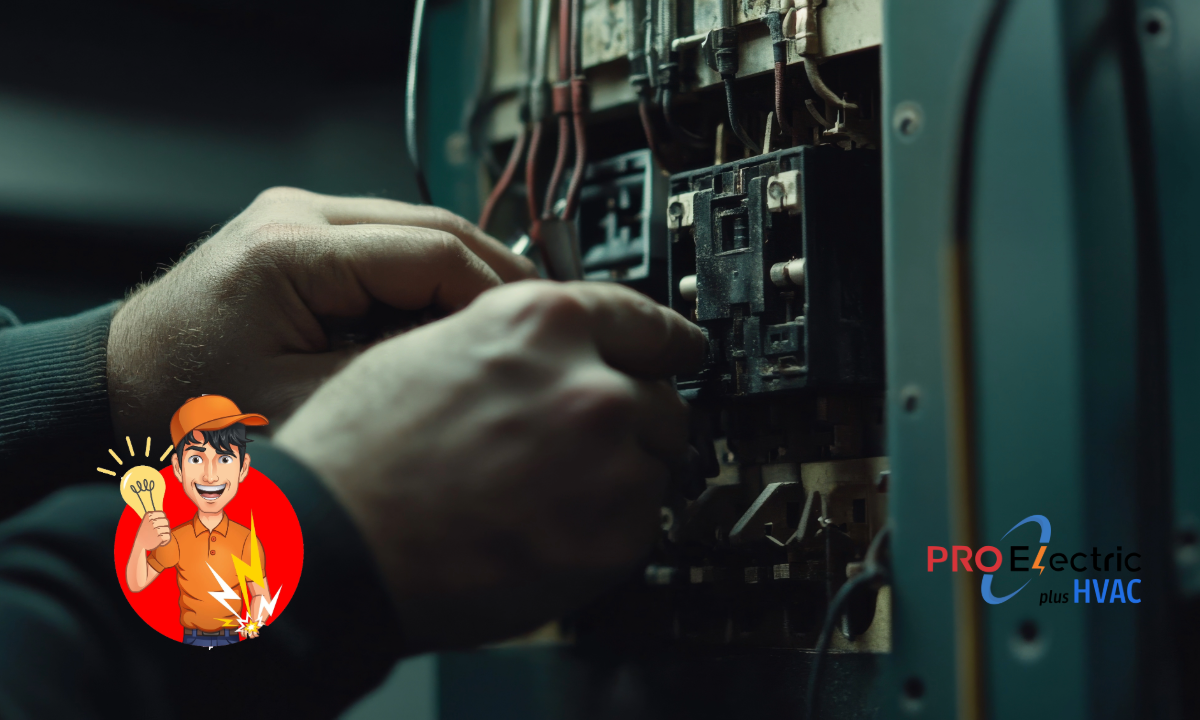By Peter, Master Electrician | PRO Electric plus HVAC | Electrical Panel Upgrades
Hi, I’m Peter, Master Electrician with PRO Electric plus HVAC. If you live in Annandale, Virginia, chances are your home was built in the 1960s or early 1970s.
The median build year here is 1968, and that single number tells me a lot. It tells me that behind many of the brick ranchers, split-levels, and colonials in Annandale sits an electrical panel that’s pushing 55 years old or more.
When I open those panels, I see names like Federal Pacific (Stab-Lok), Zinsco, and even fuse boxes.
And when I do, I think about something homeowners don’t always consider: what happens when your family’s entire electrical system relies on outdated equipment that was never built for today’s demands?
Why Annandale’s Electrical Panels Are Living on Borrowed Time
The 1960s Was a Different World
Families back then didn’t have electric cars, double ovens, home offices with four monitors, or central air conditioning in every room. A 100-amp panel was “plenty.” Fast forward to today, and that same panel is asked to power heat pumps, induction stoves, high-capacity dryers, gaming setups, and chargers for every device in the house.
The Hidden Dangers of Old Panels
- Stab-Lok Breakers That Don’t Trip: FPE Stab-Lok panels are notorious for breakers failing under fault conditions. That means wires can overheat silently.
- Zinsco Weak Bus Bars: Loose connections lead to arcing and melting plastic. I’ve seen charring so severe that the metal practically disintegrated in my hands.
- Fuse Boxes That Can’t Keep Up: Some Annandale ranches still run on fuse panels. I often find oversized fuses installed to “stop the nuisance trips”—a shortcut that leaves the house unprotected.
What It Feels Like to Live With an Undersized Panel
I can usually tell within five minutes of walking into a home if the electrical system is straining. Lights dim when the HVAC kicks on, the microwave and toaster trip a breaker together, and the panel cover feels warm to the touch.
It’s not just inconvenience—it’s a safety gap. Old panels lack AFCI and GFCI protection, which means greater risks of fire and shock.
Worse, many grounding and bonding systems from the 1960s are undersized or deteriorated. That puts both your family and your electronics at risk.
Why Upgrading Matters More Than Ever
A Safer Home for Your Family
Your electrical panel is the heartbeat of your home. If that heartbeat stutters, everything else is at risk. Replacing it with a modern 200-amp system brings in reliable breakers, safety protections, and space for future circuits.
Future-Proofing for Tomorrow
If you plan to add an EV charger, a new heat pump, or even just keep up with today’s power-hungry appliances, you’ll need the extra capacity. A new panel ensures you’re ready instead of scrambling later. Or even better, all the new health rage, an Infrared Sauna from Sun Home.
Resale Value and Inspections
Buyers today know to ask about panels. Home inspectors flag FPE and Zinsco immediately. A modern upgrade isn’t just about safety—it’s about protecting your home’s value in a competitive Fairfax County housing market.
What I Check in an Annandale Panel
Full Panel Inspection
- Panel brand and age
- Breaker fit and bus bar condition
- Double-tapped circuits or improper wiring
- Signs of overheating or corrosion
Grounding and Bonding
- Proper ground rods and clamps
- Water pipe bonding
- Continuity of grounding electrode conductor
Load Calculations
- Appliance and HVAC loads
- Future additions like EV chargers
- Spare capacity for remodeling or finished basements
What a Panel Upgrade Looks Like
200-Amp Service
This is the most common choice in Annandale. It includes a new meter base, service conductors, breaker panel, grounding upgrades, and often a whole-home surge protector.
150-Amp for Smaller Homes
For modest ranchers or townhomes, 150 amps may be enough. I always calculate loads to avoid overselling.
Safety Add-Ons
- AFCI breakers for fire protection
- GFCI breakers in kitchens, baths, and outdoor areas
- Surge protection to protect sensitive electronics
Stories From the Field
One Annandale homeowner called me because the lights flickered every time the dryer ran. Their panel was a 1968 FPE Stab-Lok with scorch marks inside. We upgraded them to a clean, code-compliant 200-amp panel. The homeowner later told me they felt safer letting their kids run electronics without worrying about a hidden fire hazard.
Another family near Wakefield Chapel had a fuse panel. They were frustrated with replacing fuses every time the AC kicked on. After upgrading, they said it felt like “moving into a modern home overnight.”
How to Get Started
Step 1: Call for a Quick Assessment
Send me a photo of your panel, or just give me the brand name. I’ll tell you if it’s one of the risky models.
Step 2: In-Home Inspection
I’ll check your entire electrical service—panel, grounding, bonding, and load needs.
Step 3: Clear Proposal
You’ll see line-item pricing for equipment, labor, permits, and inspections. No surprises, just straight answers.
A Thought to Leave You With
If your home was built in 1968, your panel has already outlived its expected service life. Think about it—would you trust a 55-year-old furnace, roof, or car without replacing it? Yet many homeowners still rely on panels that were never meant to carry today’s electrical loads.
Your family’s safety, your home’s value, and your peace of mind all depend on that gray metal box in the basement or garage. Don’t wait until the lights dim, the breakers burn, or worse.
Call PRO Electric plus HVAC and let’s make your Annandale home as safe and modern as it deserves to be.
📞 Call 703-225-822 now or book online while you’re thinking about it.



